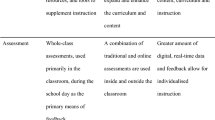Abstract
Comparing the performance of distance learning and on-campus students is a well-studied problem. Results have shown that distance learners can perform as well or better than on-campus students. Few studies, however, have explored how or why traditional on-campus students utilize the technology intended for distance learners. Many universities and corporations provide educational and training content simultaneously to both face-to-face and distance students. Thus, exploring how instructional technology typically designed for distance learning students could benefit traditional students is important to our understanding of present and future learning environments. To this end, a pilot study was undertaken that explored how graduate students – primarily business majors – adopted and used video-streaming technology for a one semester course on Knowledge Management Tools and Techniques. Results indicated that age, previous use of the technology, need for interaction and Internet connectivity all influenced the decisions of the subjects to adopt the technology. Two-thirds of the subjects used the technology, with a self-reported estimate of procuring 16% of the course content asynchronously. Most used video streaming for convenience reasons and to review class material.
Similar content being viewed by others
References
M. Alavi, Y. Yoo and D. Vogel, Using information technology to add value tomanagement education, Academy of Management Journal 40(6) (1997) 1310–1333.
P. Biner et al., Personality characteristics predicting continuing education student satisfaction with interactive telecourses, The Journal of Continuing Higher Education 45(3) (1997) 22–32.
F. Davis,Perceived usefulness, perceived ease of use and user acceptance of information technology, MIS Quarterly 13(3) (1989) 319–340.
D.R. Garrison, A cognitive constructivist view of distance education:An analysis of teaching-leering assumptions, Distance Education 14(2) (1993) 199–211.
S.Gilbert, Making the most of a slow revolution, Change 28(2) (1996) 10–24.
S.R. Hiltzand B.Wellman, Asynchronous learning networks as a virtual classroom, Communications of the ACM 40(9) (1997) 44–49.
F.Mayadas, Online networks build time savings into employeeeducation, HRMagazine 42(10) (1997) 31–35.
W. Miller and J. Webster, A comparisonof interaction needs and performance of distance learners in synchronous and asynchronous classes, Paper presented at the AVAC, Las Vegas, December 1997.
M. Moore and M. Thompson, The Effects of DistanceLearning: A Summary of the Literature (The American Center for the Study of Distance Education, University Park, PA, 1990).
J.Webster and P. Hackley, Teaching effectiveness in technology-mediateddistance learning, Academy of Management Journal 40(6) (1997) 1282–1309.
M. Weiserand R. Wilson, Using video streaming on the internet for a graduate IT course: A case study, Journal of Computer Information Systems 39(3) (1999) 38–43.
C. Wetzel et al., InstructionalEffectiveness of Video Media (Lawrence Erlbaum Associates, Hillsdale, NJ, 1994).
Author information
Authors and Affiliations
Rights and permissions
About this article
Cite this article
Wilson, R.L., Weiser, M. Adoption of Asynchronous Learning Tools by Traditional Full-Time Students: A Pilot Study. Information Technology and Management 2, 363–375 (2001). https://doi.org/10.1023/A:1011446516889
Issue Date:
DOI: https://doi.org/10.1023/A:1011446516889




